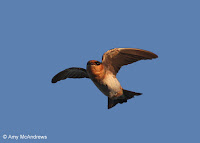CAVE SWALLOW
CAVE SWALLOW – (Petrochelidon fulva) – (See images below)
DESCRIPTION: The Cave Swallow adult has a blue-grey cap with a cinnamon forehead, rump and collar. Upper parts are brown. Breast is lighter cinnamon, under parts are whitish. Eyes and short bill are black, short legs and feet are grey. Gape is wide. Sexes are similar. Bird length is around 13 cm (5 inches). There are five subspecies.
VOICE: https://www.xeno-canto.org/species/Petrochelidon-fulva
NAME: ‘Swallow’ refers to the bird’s feeding behavior, by swallowing insects with a wide open mouth while flying. Latin genus name ‘Petrochelidon’ means ‘rock’ and ‘swallow’. Latin species name ‘fulva’ means ‘yellowish-brown’.
HABITAT: Semi-open areas near water.
DIET: Insects caught on the fly for the most part.
NESTING: Nests in large colonies inside caves. This species has also learned to use vertical surfaces of man-made structures for nesting, such as under bridges. Nest is made of bat guano and mud, is usually an open cup structures, but sometimes may be enclosed and have a side entrance. Between two and four white eggs are laid, incubated likely by both parents. Chicks fed by both parents.
DISTRIBUTION: Breeds in Texas and Cuba; year-round population in eastern Mexico and the Caribbean.
Distribution Map: https://assets.whatbird.com/api/image/birds_na_147/image/56076
ON PEI: Does not breed on Prince Edward Island, sightings listed as ‘accidental’ so far. See note below on bird vagrancy.
CONSERVATION: Population has increased, not at risk.
NOTES: Although it is named the Cave of Swallows and is located in the cave swallow range in Mexico, that species rarely nests in there. That cave is rather occupied by the White-collared Swift.
The cave swallow is known to interbreed with the Barn Swallow, and also share nesting sites with it.
Vagrancy: In biology this means an animal going way outside its normal range. For birds, this can happen when there are storms and they get blown off course. On other times, the bird simply wanders in a different direction than usual. Here’s an article about vagrancy in birds.
SIMILAR SPECIES: Cliff Swallow, Bank Swallow
REFERENCES: https://www.audubon.org/field-guide/bird/cave-swallow
https://txtbba.tamu.edu/species-accounts/cave-swallow/ (Texas Breeding Bird Atlas)
https://www.allaboutbirds.org/guide/Cave_Swallow/id
https://identify.whatbird.com/obj/782/overview/Cave_Swallow.aspx
https://en.wikipedia.org/wiki/Cave_swallow
DESCRIPTION: The Cave Swallow adult has a blue-grey cap with a cinnamon forehead, rump and collar. Upper parts are brown. Breast is lighter cinnamon, under parts are whitish. Eyes and short bill are black, short legs and feet are grey. Gape is wide. Sexes are similar. Bird length is around 13 cm (5 inches). There are five subspecies.
VOICE: https://www.xeno-canto.org/species/Petrochelidon-fulva
NAME: ‘Swallow’ refers to the bird’s feeding behavior, by swallowing insects with a wide open mouth while flying. Latin genus name ‘Petrochelidon’ means ‘rock’ and ‘swallow’. Latin species name ‘fulva’ means ‘yellowish-brown’.
HABITAT: Semi-open areas near water.
DIET: Insects caught on the fly for the most part.
NESTING: Nests in large colonies inside caves. This species has also learned to use vertical surfaces of man-made structures for nesting, such as under bridges. Nest is made of bat guano and mud, is usually an open cup structures, but sometimes may be enclosed and have a side entrance. Between two and four white eggs are laid, incubated likely by both parents. Chicks fed by both parents.
DISTRIBUTION: Breeds in Texas and Cuba; year-round population in eastern Mexico and the Caribbean.
Distribution Map: https://assets.whatbird.com/api/image/birds_na_147/image/56076
ON PEI: Does not breed on Prince Edward Island, sightings listed as ‘accidental’ so far. See note below on bird vagrancy.
CONSERVATION: Population has increased, not at risk.
NOTES: Although it is named the Cave of Swallows and is located in the cave swallow range in Mexico, that species rarely nests in there. That cave is rather occupied by the White-collared Swift.
The cave swallow is known to interbreed with the Barn Swallow, and also share nesting sites with it.
Vagrancy: In biology this means an animal going way outside its normal range. For birds, this can happen when there are storms and they get blown off course. On other times, the bird simply wanders in a different direction than usual. Here’s an article about vagrancy in birds.
SIMILAR SPECIES: Cliff Swallow, Bank Swallow
REFERENCES: https://www.audubon.org/field-guide/bird/cave-swallow
https://txtbba.tamu.edu/species-accounts/cave-swallow/ (Texas Breeding Bird Atlas)
https://www.allaboutbirds.org/guide/Cave_Swallow/id
https://identify.whatbird.com/obj/782/overview/Cave_Swallow.aspx
https://en.wikipedia.org/wiki/Cave_swallow
 |
| Cave swallow at nest, Becky Matsubara |
 |
| Cave swallow, by Amy McAndrews |
 |
| Cave swallow in flight, by Alan Schmierer |